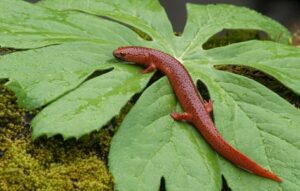If you’ve ever seen a salamander in the wild or kept one as a pet, you might already know that they’re not like most animals. But one of the most surprising things about salamanders is their ability to regrow lost body parts.
Yes, salamanders can grow their limbs back. If they lose a leg, tail, or even parts of their jaw or heart, many species can regrow those tissues completely. This isn’t just a partial repair, it’s full regeneration, right down to the muscles, bones, and nerves.
What Makes Salamanders So Special
Most animals cannot regrow lost body parts. Humans don’t regrow fingers, and dogs heal broken bones but don’t rebuild lost parts. Salamanders are different.
They can build new body parts from scratch.
This takes time and energy. The salamander’s body makes new cells, shapes them correctly, and connects them perfectly, like building a house without blueprints.
Scientists have studied this for years, hoping to understand it better and someday help humans heal the same way.
How Does Regeneration Work?
The process starts when a salamander is hurt, maybe escaping a predator or dropping its tail on purpose.
Right after injury, the wound closes quickly to stop bleeding. Then a small bump called a blastema forms.

The blastema is full of special cells that aren’t like regular skin or muscle cells. These unspecialized cells can become any cell type needed, like blank pages ready to be written on.
Over weeks, these cells organize and form the missing part’s shape. A small bud grows, slowly becoming toes, a tail, or a leg.
It can take months for the new part to fully grow, starting soft and small and becoming strong and functional over time.
What Body Parts Can Salamanders Regrow?
Salamanders can regrow:
- Limbs: all four legs with bones, muscles, and nerves
- Tails: often dropped to escape danger
- Toes and fingers: even tiny ones
- Heart tissue: parts of the heart can regrow
- Jaw and mouth parts: can heal and regrow
- Spinal cord: some parts of the backbone and nerves
- Skin and eyes: surface injuries heal, some eye damage repairs
This is far more than most animals can do, even other amphibians like frogs lose this ability as adults.
How Long Does It Take?
Regeneration is slow. Small parts like toes may take weeks; whole legs, months.
Age matters: young salamanders heal faster. Environment matters too: right temperature, clean water, and good food are needed.
Health is key. Sick or stressed salamanders heal slower. During healing, they live normally; eating, moving, hiding, while rebuilding missing parts quietly.
Do Salamanders Feel Pain?
Scientists aren’t sure. Salamanders have nerves and likely feel injury but don’t show pain like mammals.
After losing a part, they might act differently briefly, but usually return to normal. The regeneration process seems to cause little discomfort.
Why Can’t Humans Do This?
Humans heal cuts but don’t regrow limbs. Instead, we form scar tissue, tough but inflexible.
Salamanders’ bodies remember exactly how parts should be built. Their cells know shapes and connections. This memory is in their genes.

They have special signals between nerves, skin, and immune system guiding regeneration. Humans have similar signals but they don’t work the same way.
Understanding salamander regeneration could help humans heal limbs or organs one day.
Are There Any Limits?
Salamander regeneration is amazing but not perfect.
Some species like axolotls and newts regenerate better than others. Older salamanders heal slower and less fully.
Health matters. Sick or stressed animals may regrow smaller or misshapen parts.
Severe injuries or brain damage may be too much to recover from.
Is Regeneration Dangerous?
Surprisingly, no. In most cases, it’s a smooth and controlled process. But there are rare times when the new limb grows a little differently.

A digit might be missing or shaped slightly off. In some cases, a salamander might grow an extra toe or even an extra limb if the blastema doesn’t form correctly.
Still, these are rare problems. For the most part, regeneration is safe, effective, and reliable.
Unlike mammals, salamanders seem to have tight control over fast-growing cells, which helps prevent tumors or cancer. That’s another reason scientists are fascinated by them.
Caring for Pet Salamanders
Pet salamanders can regrow parts if injured, but it depends on species and injury.
Owners should provide clean water, proper food, and the right temperature for healing.
If a pet seems sick or hurt, consult a vet familiar with amphibians.
Regeneration shouldn’t be relied on, prevention of injuries is best.
Conclusion
Salamanders are unique for their ability to regrow lost parts using special cells, timing, and biological signals.
Though limits exist and mistakes happen, regeneration usually works well.
Studying salamanders may unlock ways to help humans heal better.
Until then, these small amphibians remain among nature’s greatest examples of repair and renewal.
Hi, my name is Ezra Mushala, i have been interested animals all my life. I am the main author and editor here at snakeinformer.com.

